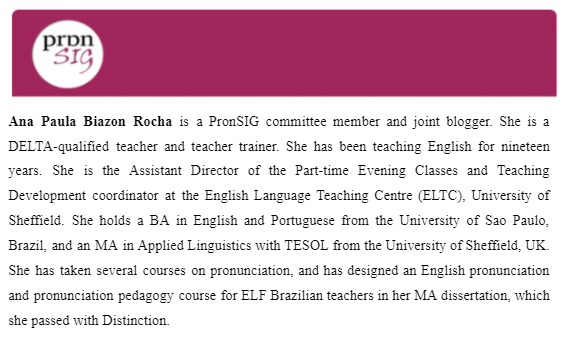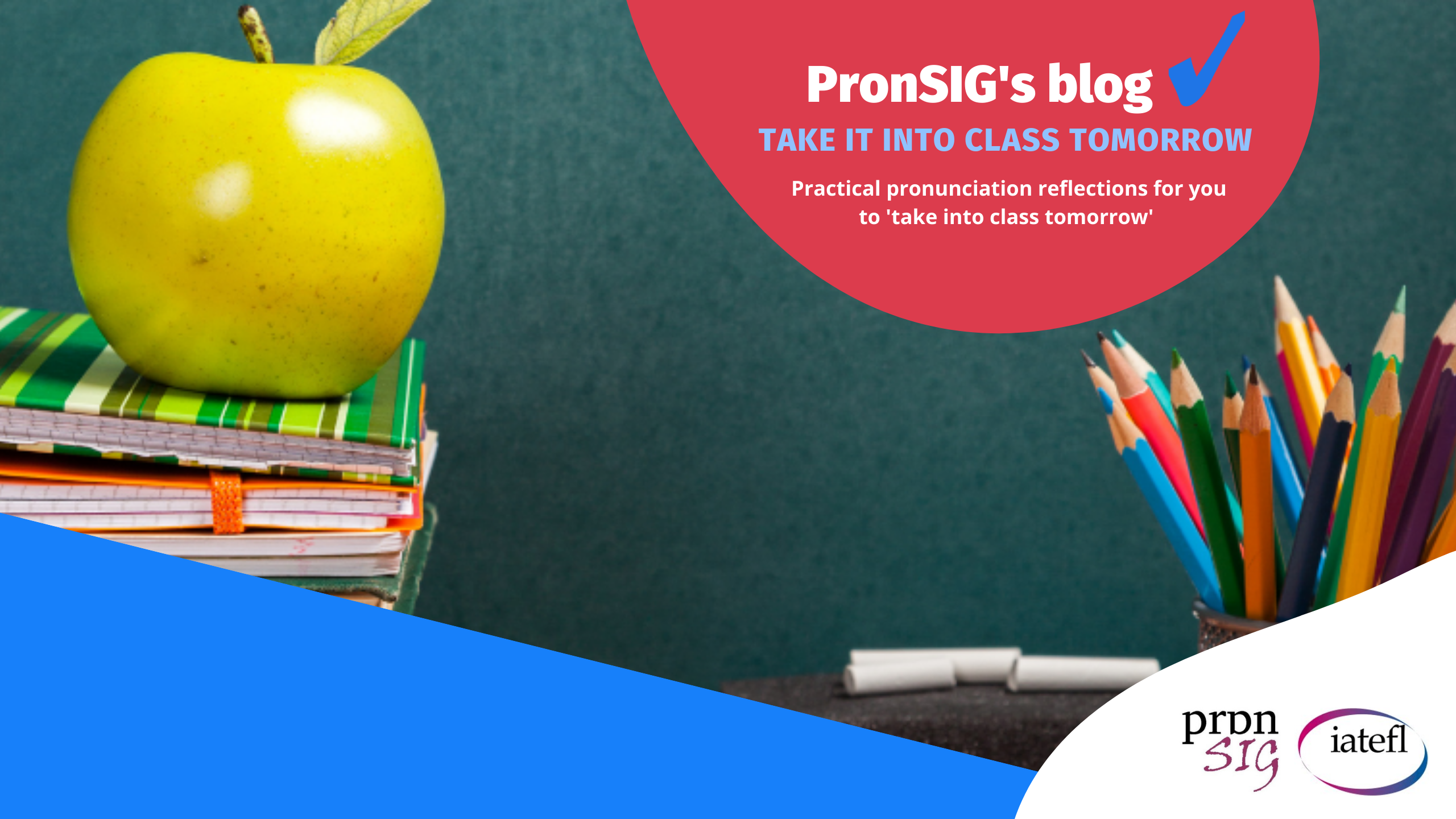by Ana Paula Biazon Rocha
As constantly reiterated in this blog ever since its beginning, lack of confidence, skills or adequate training and preparation lead a great number of teachers to shy away from teaching pronunciation (Derwing & Munro, 2015; Levis, Derwing & Sonsaat-Hegelheimer, 2022; Murphy, 2017). On top of that, sometimes the sequence of pronunciation activities presented in many English coursebooks does not seem very logical or might lack further communicative practice. In other words, asking students to listen to some sounds or words, notice the difference between them, and then listen and repeat some words or sentences may not suffice because in communication, interlocutors usually do not say random words in isolation or at will, but within a flow of speech, which is structured by their interaction and by the context.
Based on the principles of Communicative Language Teaching (CLT), Celce-Murcia et al. (2010) developed ‘a communicative framework for teaching pronunciation’ (p. 44) which helps teachers better envision how to approach pronunciation and plan their lessons accordingly. The authors claim that ‘the communicative framework suggests a division of the pronunciation lesson into five phases moving from analysis and consciousness raising to listening discrimination and finally production’ (p. 45). Sicola and Darcy (2015) explain that the framework provides a combination of form and meaning when teaching and learning pronunciation.
Thus, to try and understand what the framework is and illustrate each stage, let’s use two pronunciation exercises (1D and 1E) retrieved from Doff et al. (2015, p. 47, Lesson 4B), Empower B1+, and expand them. In the vocabulary lesson, students practice
–ed/-ing adjectives such as amused/amusing, depressed/depressing, interested/interesting, etc.
Communicative Framework for Teaching Pronunciation (Celce-Murcia et al., 2010, p. 45)
1. Description and Analysis – the teacher introduces the pronunciation feature by explaining how it is produced and how it occurs in speech:
The final -ed sound in adjectives can be pronounced as
- /d/ after voiced consonants: amused /əˈmjuːzd/
- /t/ after voiceless consonants: depressed /dɪˈprest/
- /ɪd/ after consonants /t/ and /d/: interested /ˈɪntrestɪd/
2. Listening Discrimination – through listening practice, learners try to discriminate the feature:
Exercise 1D contains a list of adjectives, namely amused, bored, depressed, disappointed, fascinated, interested, relaxed, satisfied, terrified, and a table with the three final -ed sounds, /d/, /t/ and
/ɪd/. Students should listen to each adjective and write it under the correct sound in the table, for example: /d/ bored. In Exercise 1E, students listen to the track again and correct their answers.
3. Controlled practice – the teacher asks students to read words or sentences, or a short dialogue, focusing on the feature, to raise their awareness of it:
Still in exercise 1E, students listen and repeat the adjectives. Then, the teacher can also come up with some sentences using the adjectives in exercises 1D and 1E for students to read, for example:
- I’m terrified of being late to class.
- My mum is interested in learning how to cook different kinds of food.
- My friend is fascinated by the stars and planets.
- I’m so bored, there’s nothing to do in this town.
- We were really disappointed that the concert was cancelled.
4. Guided practice – learners do a more structured communication activity, such as information-gap or a dialogue with some cues, to focus on the target feature:
Student A reads one of the sentences above and student B reads the correct reply (from a list of replies provided by the teacher), and vice-versa.
A: I’m terrified of being late to class.
B: So am I, but sometimes I feel like sleeping a bit more.
B: I’m so bored, there’s nothing to do in this town.
A: Why don’t we go for a walk or watch a movie?
5. Communicative Practice – learners do a less controlled activity, such as a role-play, a problem-solving task, telling a story, a board game, etc., where they can work on fluency:
Students play a board game where they should talk about how they felt the last time something happened. They should use the -ed adjectives as much as possible, and other adjectives as well to express their feelings.
In this way, through the communicative framework, it is possible to expand the pronunciation activities suggested in the coursebook to contextualise the pronunciation feature, focusing on a clear communicative purpose.
Nevertheless, the communicative framework is not the solution to all pronunciation teaching issues and it does not work miracles. For Pennington (2021, p. 16), the framework is ‘a relatively diverse and complex lesson design, containing many different kinds of instructional components’. Similarly, Rothgerber (2020, p. 01) comments that the framework is ‘well-suited for a course focused entirely on pronunciation, but it can be difficult to implement in a more general communication or multi skills course, both in terms of in-class time and preparation time’. Indeed, within a fixed and time-constrained course curriculum, many times there are not enough opportunities to include pronunciation, let alone a lesson divided into five different stages. However, this does not mean that teachers should not use at least some of the stages of the framework as a guide to plan and introduce pronunciation activities in class more confidently, or go beyond what is given in the coursebook. In other words, it is better to have something than having nothing at all, isn’t it?
Finally, the main point of teaching pronunciation communicatively does not seem to stray too much from one of the pillars of language teaching: to prepare learners for real-life communication, where meaning should be conveyed effectively.
For more examples of pronunciation activities inspired by Celce-Murcia et al.’s communicative framework, check Miller (2007), Grant (2017) and Grant and Yu (2017).
For more tips, ideas and discussions on pronunciation teaching, please check our previous blog posts, and spread the word. Don’t forget to follow PronSIG on social media, leave your comments below, and register for our online conference on 14 Oct 2023.
References
Celce-Murcia, M., Brinton, D. M., & Goodwin, J. M. (with Griner, B.). (2010). Teaching Pronunciation: A Course Book and Reference Guide. Second Edition. Cambridge University Press.
Derwing, T. M., & Munro, M. J. (2015). Pronunciation fundamentals: Evidence-based perspectives for L2 teaching and research. Amsterdam: John Benjamins Publishing Company.
Doff, A., Thaine, C., Puchta, H., Stranks, & Lewis-Jones, P. (2015). Empower B1+ Student’s Book. Cambridge University Press.
Grant, L. (2017). Well Said. Pronunciation for Clear Communication. Fourth Edition. National Geographic Learning.
Grant, L. & Yu, E. E. (2017). Well Said Intro. Pronunciation for Clear Communication. Second Edition. National Geographic Learning.
Levis, J., Derwing, T. & Sonsaat-Hegelheimer, S. (2022). Second Language Pronunciation. Bridging the Gap Between Research and Teaching. Hoboken and West Sussex: Wiley Blackwell.
Miller, S. F. (2007). Targeting Pronunciation. Communicating Clearly in English. Second Edition. Heinle Cengage Learning.
Murphy, J. (2017). Teaching the Pronunciation of English: Focus on Whole Courses. USA: The University of Michigan Press.
Pennington, M. C. (2021). ‘Teaching Pronunciation: The State of the Art 2021’, RELC Journal, 52(1), p. 3-21.
Rothgerber, J. (2020). ‘Making Time for Pronunciation Instruction: 6 Strategies’, TESOL Connections, p. 1-4. Available at http://newsmanager.commpartners.com/tesolc/downloads/features/2020/2020-04_Pronunciation%20Instruction.pdf . Accessed on 27 Sep 2023.
Sicola, L & Darcy, I. (2015). Integrating Pronunciation into the Language Classroom. In Reed, M. & Levis, J. (Eds.), The Handbook of English Pronunciation. Chichester, West Sussex, England: Wiley Blackwell. p. 471-487.



What a brilliant blog, Ana!
Grazie mille, Mary.:)
We at PronSIG really appreaciate it.
Best,
Ana.